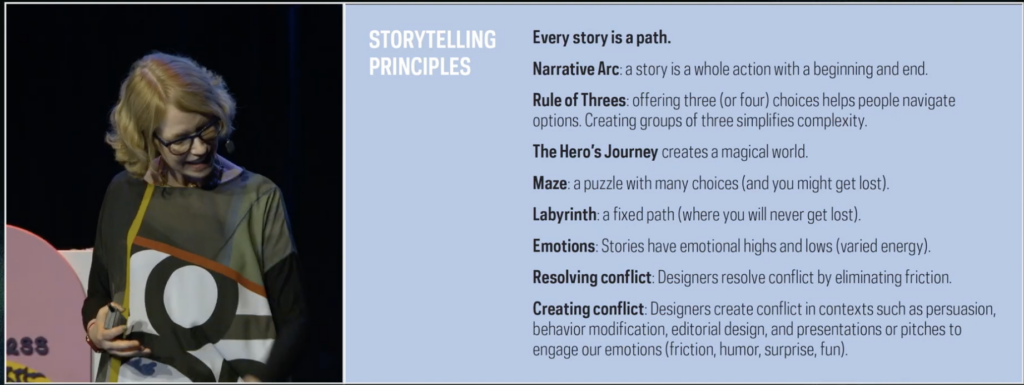I was intrigued when I heard the term „storytelling in design,“ so I wanted to explore it further and see where it could be applied. While searching the internet, I came across an interesting video on YouTube of Ellen Lupton’s lecture at the „From Business to Buttons 2023“ conference about storytelling and visual design. In her lecture, she discusses how storytelling can significantly impact design and its meaningfulness. Design is not just about aesthetics; it’s a way of communicating ideas, emotions, and messages. Through her presentation, she explained how storytelling principles can help designers convey strong messages and build deeper connections with their audience.
Lupton begins her talk with the statement that every design, whether digital or physical, is a form of storytelling. Designers create entire journeys through interactions with a product or service, but also countless small interactions along the way. She compares this to a story, explaining how every story needs action and emotion. A good story presents the action in an engaging way, resulting in a satisfying emotional response. As designers, we create action—which is the narrative—and then wrap it in emotions by creating various atmospheres through colors, fonts, layouts, and so on. That’s why she says every path is its own story. Sometimes the path itself is so strong that it becomes a character in the story, like the highway in the movie Mad Max. It introduces us to the story, like an invitation. And even though it may seem like the path is straightforward, we must take a leap, and we’ll discover that somewhere along the way, there are curves. Additionally, every story has a beginning, middle, and end, just like in design. Users experience a journey, starting from their first contact with a product to the point of making a decision—an action.
The second thing she mentions is the rule of threes. She explains that it’s easier for users when they have three options rather than too many, like when choosing movies on Netflix. Having fewer options makes it easier for us to decide. For this reason, information is often grouped into threes, simplifying complex information and making it easier to understand. These principles are also used in restaurants like McDonald’s. This rhythm can also be used to create an unexpected moment of surprise, like in an advertisement for a product. Additionally, it can be applied in dashboard design to visually separate information for easier comprehension.
Another narrative model she mentions is the Hero’s Journey. The protagonist is a person who typically goes to a different, magical world, experiences new and exciting things, faces challenges, and then returns home—it’s always a circle. Designers, through their decisions, create that “magical world” into which the user enters, inviting them into a “green world.” This is why some applications use green. She also mentions examples of purple for mystical/magical vibes or neutrals for natural products. It all depends on what the product is about and the atmosphere we want to create. What’s also important is designing the experience as a labyrinth that leads the user to their goal, creating a sense of security or excitement. Throughout the experience, it’s essential to include the previously mentioned emotions. One of the most powerful emotions is humor, but it can also be surprise or even suspense. These create engagement and energy, building a connection with the product.
The last concept she mentions is resolving and creating conflict. Resolving conflict involves eliminating pain points users encounter, thereby creating a better experience. On the other hand, creating conflict can involve using red to emphasize that something is wrong, pop-up messages that indicate an error, or notifications that warn users they’ll lose their streak, like in Duolingo.

Beyond static elements, she highlights the importance of interactivity in digital design. Every interaction a user has with a design is part of the narrative. For example, smooth and intuitive interactions can give users a sense of control and satisfaction, while design tricks like animations can create “magic” in their experience. This helped me view my project more holistically and consider how I could make it more engaging for users in a fun and story-like way.
*ChatGPT was used to summarize and translate text from Croatian to English